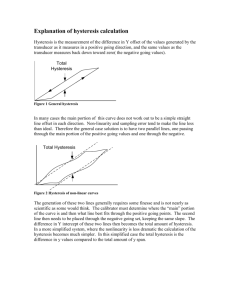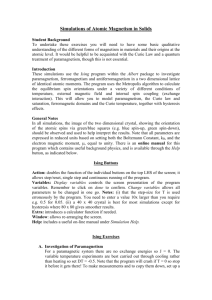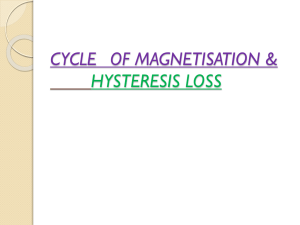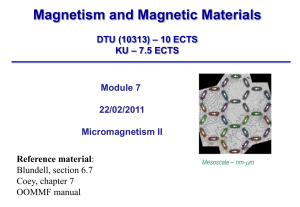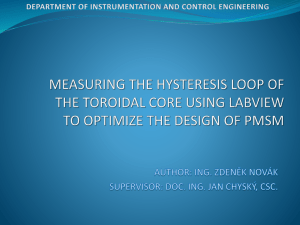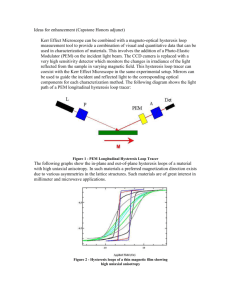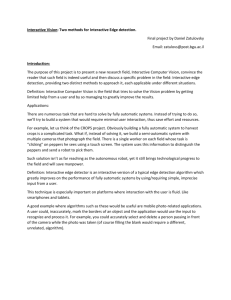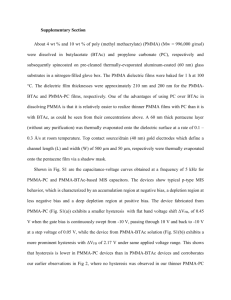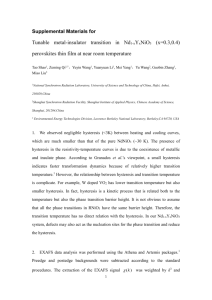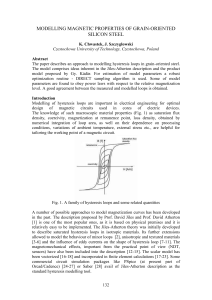COMPARATIVE STUDY ON THE ANALYTICAL MODELS OF
advertisement
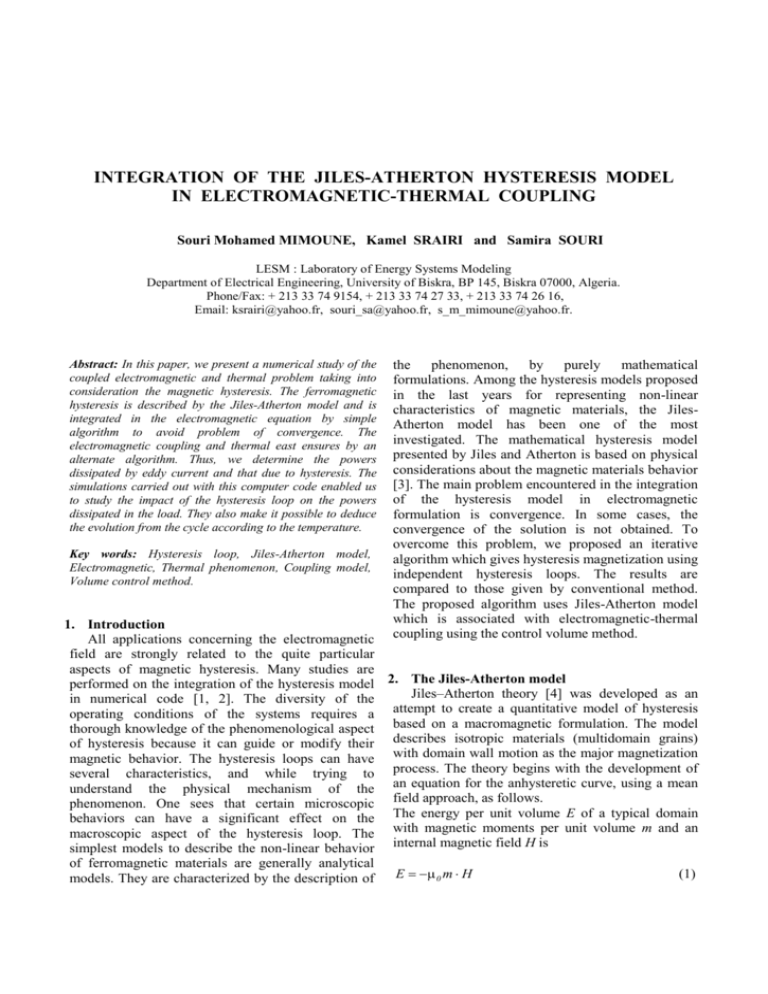
INTEGRATION OF THE JILES-ATHERTON HYSTERESIS MODEL IN ELECTROMAGNETIC-THERMAL COUPLING Souri Mohamed MIMOUNE, Kamel SRAIRI and Samira SOURI LESM : Laboratory of Energy Systems Modeling Department of Electrical Engineering, University of Biskra, BP 145, Biskra 07000, Algeria. Phone/Fax: + 213 33 74 9154, + 213 33 74 27 33, + 213 33 74 26 16, Email: ksrairi@yahoo.fr, souri_sa@yahoo.fr, s_m_mimoune@yahoo.fr. Abstract: In this paper, we present a numerical study of the coupled electromagnetic and thermal problem taking into consideration the magnetic hysteresis. The ferromagnetic hysteresis is described by the Jiles-Atherton model and is integrated in the electromagnetic equation by simple algorithm to avoid problem of convergence. The electromagnetic coupling and thermal east ensures by an alternate algorithm. Thus, we determine the powers dissipated by eddy current and that due to hysteresis. The simulations carried out with this computer code enabled us to study the impact of the hysteresis loop on the powers dissipated in the load. They also make it possible to deduce the evolution from the cycle according to the temperature. Key words: Hysteresis loop, Jiles-Atherton model, Electromagnetic, Thermal phenomenon, Coupling model, Volume control method. the phenomenon, by purely mathematical formulations. Among the hysteresis models proposed in the last years for representing non-linear characteristics of magnetic materials, the JilesAtherton model has been one of the most investigated. The mathematical hysteresis model presented by Jiles and Atherton is based on physical considerations about the magnetic materials behavior [3]. The main problem encountered in the integration of the hysteresis model in electromagnetic formulation is convergence. In some cases, the convergence of the solution is not obtained. To overcome this problem, we proposed an iterative algorithm which gives hysteresis magnetization using independent hysteresis loops. The results are compared to those given by conventional method. The proposed algorithm uses Jiles-Atherton model which is associated with electromagnetic-thermal coupling using the control volume method. 1. Introduction All applications concerning the electromagnetic field are strongly related to the quite particular aspects of magnetic hysteresis. Many studies are performed on the integration of the hysteresis model 2. The Jiles-Atherton model Jiles–Atherton theory [4] was developed as an in numerical code [1, 2]. The diversity of the attempt to create a quantitative model of hysteresis operating conditions of the systems requires a thorough knowledge of the phenomenological aspect based on a macromagnetic formulation. The model of hysteresis because it can guide or modify their describes isotropic materials (multidomain grains) magnetic behavior. The hysteresis loops can have with domain wall motion as the major magnetization several characteristics, and while trying to process. The theory begins with the development of understand the physical mechanism of the an equation for the anhysteretic curve, using a mean phenomenon. One sees that certain microscopic field approach, as follows. behaviors can have a significant effect on the The energy per unit volume E of a typical domain macroscopic aspect of the hysteresis loop. The with magnetic moments per unit volume m and an simplest models to describe the non-linear behavior internal magnetic field H is of ferromagnetic materials are generally analytical E 0 m H (1) models. They are characterized by the description of The total energy of the ferromagnetic solid must also consider the coupling between domains. This can be most easily expressed by E 0 M H e (2) Where: H e H M (3) and is an experimentally determined mean field parameter representing interdomain coupling. The response of the magnetization, in the direction of the applied field, to this effective field may be written as M M s f H e dM irr M an H e M irr dH k M an H e M irr (8) The component of reversible magnetization reduces the difference between the prevailing irreversible M irr magnetization and the anhysteretic magnetization M an at the given field strength. This can be expressed as M rev cM an H M irr (9) (4) Where f is an arbitrary function that takes the value zero when H e is zero and one when H e goes to infinity. M s is the saturation value. Jiles and Atherton derived, for the case of an isotropic ferromagnetic, a function which obeys these criteria, namely a modified Langevin function [5]. H a M M s coth e a He (5) where a is a constant with dimensions of magnetic kT . field, a 0 m The energy of the material is then equal to the energy supplied to the material if it were anhysteretic, reduced by the energy lost in overcoming the pinning sites, so the energy balance becomes 0 M an H dH 0 M dH 0 k Equation (4) above may be rearranged, providing k 0 and k M an M irr 0 , to give the equation for the differential irreversible susceptibility: dM dH dH (6) Where M is total magnetization and where is a directional parameter equal to 1 for increasing H and 1 for decreasing H . Where c is a constant. Hence, the total magnetization is: M cM an H e 1 c M irr (10) The application of such algorithm for the determination of the hysteresis loops supposes the knowledge of the five parameters. The five parameters M s , a , , k ,c can now be considered functions of the frequency, while their meaning, in the static case is: 1) Magnetization saturation, M s ; 2) Shape parameter, a ;3) mean-field parameter, ; 4) domain wall pinning constant, k ; 5) domain wall flexing constant c [6] . 3. Integration method of hysteresis in finite control volume code The electromagnetic problems are described by Maxwell equations local. In the case of magnetodynamics one a: - The Faraday law: curl E B t (11) - The Ampere law: dM M an H M k dH (7) curl H J (12) - The flux conservation law: div( B ) 0 (13) where: B : The magnetic induction [T]. E : The electrical field [V/m], H : The magnetic field [A/m], : The current density [A/m2]. J Magnetic behavior (hysteresis) of material must be associated to Maxwell equations: B 0 H M H such a called system upon the numerical methods. We have uses the method volume control method. The volume control methods can be seen as being an alternative of the method of collocation by under fields [7, 8]. The field of study is divided into a number of elements. Each element contains four nodes of the mesh. A volume control method surrounds each node of the mesh (Fig. 1 and 2). The partial equation with the derivative is integrated in each elementary volume. To calculate the integral on this elementary volume, the unknown function is represented using a function of approximation (linear, exponential… etc) between two consecutive nodes. (14) 0 4 10 7 H / m M : Hysteresis magnetization The equation (15) expressed in terms of vector potential is obtained by assuming the constitutive relationship (14). 0 A curl curl A 0 J curl M t (15) Fig. 1. The studied domain mesh. : Electrical conductivity. In axisymmetric coordinates the equation (12) gives: A 0 A 0 A M z M r Js r r r z r z r z r t A A (16) Where A A r , z ,t is the magnetic vector potential modifying, J s is the current density of the source, M r the projection of magnetization M on the axis r and M z its projection on the axis z. The system of equation developed previously is described by derivative partial. The resolution of Fig. 2. The graphical volume control method description. One integrates the equation (16) in time and space, on the volume control method, corresponding to the node P, and delimited by the borders (e, w, n, s). t t n A A A 0 dr dz dt 0 r r z r z r t r w e t s t t n e J t s s w M z M r dr dz dt r z After integration one will have: 0 z t 0 z t 0 r t 0 r t rs r s re r e rw r w rn r n A P P r z rP z t z t r t 0 AE 0 AW 0 AN rw r w rn r n re r e r t 0 A r r S s s P A P t t r z J s r z t rP M z e M z w z t M r n M r s r z Thus, the condensed algebraic equation is written then in the form: b P A P b e A E b e A W b e A N b e A S P r z A P ( t t ) dP rP t M z e M z w z M r n M r s r where: be bn 0 z , re r e 0 r , rn z n bw bs 0 z , rw r w 0 r , rs z s bP be bw bn bs P r z , rP t d P J s r z . If the discretization of the field comprises N nodes, one is caused to studied a system of N unknown equations to N. 4. Method of resolution The method used for the resolution of problem non-linear is a method of the fixed point [9]. This method using the model of hysteresis in direct form to be characterized by facility from its implementation. It consists in finding the solution of the system to an iteration given starting from the solution to the iteration chair. The calculation of a total tolerance can be based on the potential vector A , this does not have any major effect on the result. Furthermore use of A for this calculation allows a rapid convergence and a saving of time of resolution. The following table presents the steps of resolution at each iteration. Table 1. The iterative algorithm steps. 1. 2. 3. 4. 5. 6. Initialization : k=1 (time), i=1(space), give Initialization of J k and M i Calculate A i from equation (15) Calculate precision if convergence : i=i+1 go to 6 if no convergence : i=i+1 go to 3 7. Calculate B from B curl A 8. Calculate M i from hysteresis model 9. Calculate H i from equation (14) 10. k=k+1, i=i+1 The procedure of iterative resolution, the code computer volume control method 2D as well as the model of Jiles-Atherton was developed using environment MATLAB. 5. Test problem modeling It is a device of composes of a magnetic cylinder length a 20 cm and with a diameter 5 cm, this cylinder are surrounded by the same reel length. The conductors which constitute the inductor have a diameter D=1 cm the air-gap is E=2 cm figure (3). The material in characterized by the hysteresis loop represented in figure (1). Taking into account the axisymmetric nature of problem, one considers only both known field. In our study we apply temperature effect on coercive field. Its evolution affected by parameter is described by equation (18). In addition, its evolution with temperature. T Tc H c T H cTa 1 exp (18) 7. Fig. 3. The induction heating device. The studied material has characteristic the following with T=25 C° : Coercive field: Hc=1000A/m, Saturation field : Hs= 15000 A/m, Saturation magnetization: Ms=1.8 T, Electrical conductivity: =0.6*106 S/m, The inductor by: Current density : J=106 A/m2. 6. Temperature effect on hysteresis cycle The effect of temperature on hysteresis cycle is introduced by parameter [10]. It depends with material temperature T, Curie temperature Tc and corrector coefficient figure (4). T Tc T 1 exp (17) Fig. 4. The parameter f T with (Tc = 760 ° C, 150 ). Coupling algorithm with integration of hysteresis The magnetic and thermal problems are generally dependant via the dissipative power (by hysteresis and Foucault currents). Considering the nonlinear behavior of the magnetic characteristics and the variation of the physical properties according to the temperature, a complete study of a device requires an electromagnetic and thermal analysis [11]: 1 A curl A T J s curl M (H, T) curl t 0 (19) T C p T div ( (T) grad (T)) Pt t : Masse density, : Thermal conductivity, C p : Specific heat density, Pt : Average power density. Considering the time-constants of the thermal problem are very large compared to those of the magnetic problem, one will consider the average values of the electric outputs obtained in steady state. The densities of average powers dissipated in the load are evaluated at the end of several periods with the transient state is exceeded. To calculate the temperature field, it is important to have a good accuracy in the evaluation of the dissipated power. We use then the vector potential formulation to solve the electromagnetic equation. The matrix resulted from the control volume method for the coupled electro-magneto-thermal equation is nonlinear and nonsymmetrical. These difficulties can be alleviated if the entire matrix is not inverted globally to yield the solution, but is partitioned into several sub matrices to present the electromagnetic matrix, the thermal matrix and the coupling matrices. 8. Results To solve the electromagnetic problem in an iterative way, the geometry of the device, the behavior of hysteresis and the density of current operation are present in the calculation volume control method which integrated the new algorithm. The results of simulations are given in the figures (5, 6). Theoretical hysteresis is obtained by the calculation of model of Jiles-Atherton. We notice the good agreement between the magnetization obtained by the model of Jiles-Atherton and by calculation of volume control method that is mainly with the criterion of employed precision, like with the value of the number of considered steps. As it defined in the sixth paragraph, the hypothesis of work is the application of temperature effect on coercive field. The application of such hypothesis leads to results presented in figure (7). We can notice that we obtain the well-known variation of Ms with temperature [12]. Simulations of the behavior of material at various temperatures (25°C< T < 825°C) make it possible to calculate the losses by eddy currents and the losses by hysteresis. We defined on this geometry four points of reference on which we will determine the forms of wave the field and induction as well as the hysteresis loop traversed. The coordinates of these points Figure (8). Contrary to induction, the magnetic field is distorted considerably. In the figure (9, 10) one can distinguish this distortion as well as the delay introduced by hysteresis between the field and induction. The hysteresis loops described at the points previously definite are indicated in figure (11). Fig. 6. Hysteresis loop for a number of steps equal to 32. ( ----- : Jiles-Atherton model, ++++ : Volume control model). Fig. 7. Evolution of the hysteresis loop under the effect of the temperature. Fig. 8. Positions of the points. Fig. 5. Hysteresis loop for a number of steps equal to 20. (----- : Jiles-Atherton model, ++++ : Volume control model). Note that: P1 (0.0242, 1.1), P2 (0.0242, 1.0534), P3 (0.0182, 1.1) and P4 (0.0182, 1.0534). Dimensions are in meter. Fig. 9. Evolution of inductions for the four points. 9. Conclusion The consideration of the hysteresis phenomenon in the study of operation or dimensioning of an electromagnetic device with magnetic hysteresis is capital for the reliability of simulation results. We conclude that magnetic hysteresis is well integrated, from share the values close to the inductions obtained by the hysteresis model and the computer code based on volume control method for a field of a given excitation. A study of magnetic behavior of ferromagnetic sample considered in a test problem is performed to confirm convergence at critical points of hysteresis curve. This study leads to a better knowledge of different parameters for the convergence procedure in control volume method calculation including hysteresis behavior. The loss by hysteresis would be, thus, impossible to be unaware of their effects on the change of the temperature, and consequently it influences the deformation of cycle. A more rigorous study can also be taken in to account in the non-linear aspect of the specific heat, thermal conductivity and the magnetic resistivity according to the temperature. 1. 2. Ossart F., Meunier G.: Results on modeling magnetic hysteresis using the finite element method. In: Journal of Applied Physics (1991), Vol. 68, No. 8, 1991, p. 48354837. 3. Jiles and Atherton : Theory of ferromagnetic hysteresis. In: Journal of magnetism and magnetic materials (1986), Vol. 61, 1986, p. 48-60. 4. Jiles and Atherton : Ferromagnetic hysteresis. In: IEEE Transactions on Magnetics (1983), Vol. 19, No.5, 1983, p. 2183-2184. 5. Ouled Amar Yassine: Contribution à la Modélisation de l’Hystérésis Magnétique vue de l’Analyse par Eléments Finis des Systèmes de Chauffage par Induction. (Thèse de Doctorat), Université de Nantes, France, 2000. 6. Francesco Riganti Fulginei and Alessandro Salvini, Soft computing for the Identification of the JilesAtherton Model Parameters. In: IEEE Transactions on Magnetics (2005), Vol. 41, No.3, 2005, p. 1100-1108. Figure (10): Evolution of the fields for the four points. Fig. 11. Hysteresis loops for the four points. References Henrotte F., Nicolet A., Delincé F., Genon A. and Legros W.: Modeling of ferromagnetic materials in 2D finite element problem using Preisach’s model. In: IEEE Transactions on Magnetics (1992), Vol. 28, No. 5, September 1992. 7. Féliachi M. and Develey G.: Magneto-Thermal Behavior Finite Element Analysis for Ferromagnetic Materials in Induction Heating Devices. In: IEEE Transaction on Magnetics (1991), Vol. 27, No. 6, November 1991, p. 5235-5237. 8. Develey G. : L’induction : Effets Thermiques et Mécaniques. Rappel des Bases Théoriques. In : Congrès International : L’induction dans les procédés industriels. Paris, France, Mai 1997. 9. Ossart F. and Meunier G.: Results on modelling magnetic hysteresis using the finite element method. In: Journal of Applied Physics (1991), Vol. 68, No. 8, 1991, p. 4835-4837. 10. Ouled Amor Y. and Féliachi M.: Magnetic hysteresis and its thermal behavior in finite element computing. In: ELECTRIMACS’99, Vol. 3, 1999, p. 361-364. 11. Ouled Amor Y. and Féliachi M.: Prise en compte de l’hystérésis magnétique dans la modélisation du chauffage par induction. Colloque EF’99, 1999, p. 206-209. 12. H. Bleuvin, Analyse par la méthode des éléments finis des phénomènes magnéto-thermiques – application aux systèmes de chauffage par induction. (Thèse de doctorat), Institut National Polytechnique de Grenoble, France, 1984.
